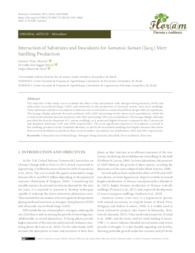Interaction of substrates and inoculants for Samanea Saman (Jacq.) Merr seedling production.
Interaction of substrates and inoculants for Samanea Saman (Jacq.) Merr seedling production.
Author(s): ABAURRE, G. W.; SAGGIN JUNIOR, O. J.; FARIA, S. M. de
Summary: The objective of this study was to evaluate the effect of the inoculation with nitrogen-fixing bacteria (NFB) and arbuscular mycorrhizal fungi (AMF) and substrates in the production of Samanea saman (rain tree) seedlings. Three substrates and three inoculation treatments were combined in a randomized block design with six repetitions. The Sewage Sludge substrate favored symbiosis with AMF (promoting twelve times more sporulation), while the Commercial substrate favored symbiosis with NFB (promoting 70% more nodulation). The Sewage Sludge substrate provided the best development of S. saman seedlings, as it promoted higher biomass compared to the Commercial and Standard substrates (14% and 150% respectively). The most significant response to inoculation occurred in the seedlings produced in the Standard substrate, in which the inoculated seedlings had higher biomass than those that received fertilization and those that received neither inoculation nor fertilization (20% and 50% respectively).
Publication year: 2021
Types of publication: Journal article
Unit: Embrapa Agrobiology
Keywords: Arbuscular mycorrhizal fungi, Rain tree, Root symbiosis
Observation
Some of Embrapa's publications are published as ePub files. To read them, use or download one of the following free software options to your computer or mobile device. Android: Google Play Books; IOS: iBooks; Windows and Linux: Calibre.
Access other publications
Access the Agricultural Research Database (BDPA) to consult Embrapa's full library collection and records.
Visit Embrapa Bookstore to purchase books and other publications sold by Embrapa.

